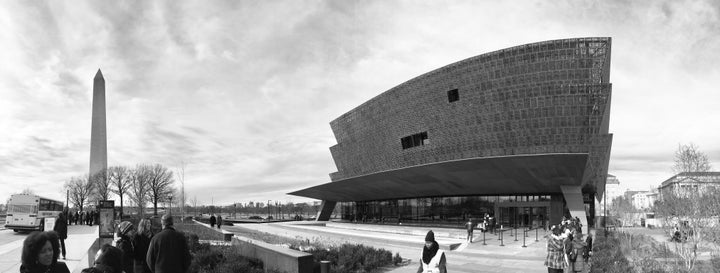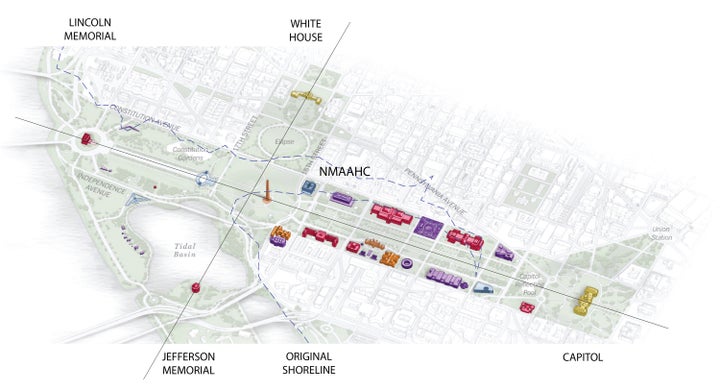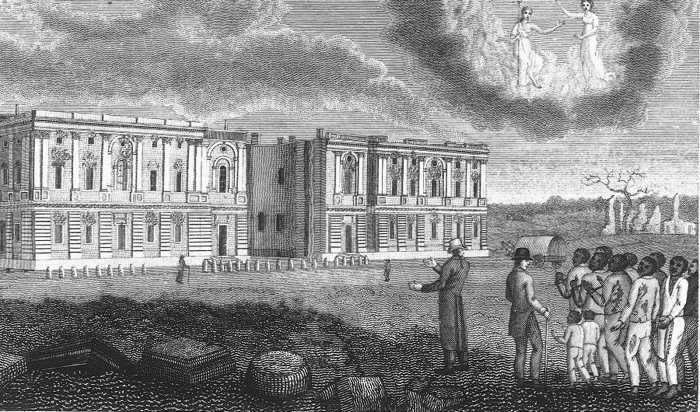The new National Museum of African American History and Culture has a complicated relationship with Washington, DC. (The first in a series of articles on the museum.)

The NMAAHC and the Washington Monument.
Every city has a hidden history. The 17th-Century founding of New Amsterdam crowded out thousands of Lenape people, who for centuries had lived the land now known as New York City. Chicago’s proud architecture says nothing about the devastating ecological toll its construction took on the region’s forests and prairies in the 19th Century. And the ever-spreading development of Los Angeles is silent about the political war over water rights that preceded the city bursting forth in the early 20th Century.
Washington, DC, has its own secret stories. In fact, this city has no business being here.
While histories of Washington often begin with the establishment of the capital in 1790, in actuality Native Americans had occupied the banks of the Potomac River for 4,000 years. By the end of the 18th Century Georgetown and Alexandria had become thriving Colonial ports, after displacing many tribes of Algonquians to outer Virginia and Maryland. As the seat of government of a fledgling nation, the marshy plot of land wedged between the Potomac and Anacostia rivers was an unlikely choice. The largest city in the country, New York, was twice the size of any city in the South and already served as the Continental Congress’ meeting place. Alexander Hamilton, a New Yorker, solicited support from Virginians Jefferson and Madison to propose the Residence Act, which created the capital city in Washington. As the new Secretary of the Treasury, Hamilton wanted to consolidate considerable debts racked up by the states during the Revolution. The North owed more than the South, which had become wealthy from the exploding sugar and cotton industries, wholly dependent on slavery. Some Northern states already had abolished slavery, and the South feared losing power. Hamilton proposed a compromise: the South would assume debt from the North if the capital were moved to the border of Virginia and Maryland. An avid abolitionist, he nevertheless helped strengthen the institution of slavery by putting the nation’s center of power in the South. Historically, the very existence of the city is bound up with “America’s original sin.”
The Smithsonian’s new National Museum of African American History and Culture (NMAAHC), which opened this Fall, makes all this explicit in its exhibits but also implicit in its very presence on the National Mall. In recent months, much has been written about the museum, but little if any media attention has thoroughly addressed the building’s complicated relationship with the city.

The NMAAHC on the National Mall, labeled with major monuments and the original shoreline of the Potomac River and Tiber Creek.
The location itself speaks volumes. The building stands on land once home to slave markets, common along the Mall in the early 19th Century. Slaves built many of the iconic structures along the Mall, including the White House and the Capitol, dubbed the “Temple of Liberty,” as well as the Smithsonian itself, as research recently discovered. Martha Washington is believed to have provided the slaves who quarried stone for the original building, James Renwick’s “Castle.” Andrew Jackson, one of ten US Presidents who were slave-owners, presided over the Smithsonian’s founding in 1836, and Jefferson Davis, soon to be president of the Confederacy, sat on the Board of Regents and actually served on the committee overseeing development of the Castle, so the museum itself has a tainted past that it reportedly has been reluctant to acknowledge.
Originally, the west end of the Mall was under water. Prior to the McMillan Plan of 1901, which proposed a significant extension westward, the NMAAHC site was at the mouth of Tiber Creek, below the Washington City Canal, which cut off the Mall from downtown. According to the historic preservation report prepared for the Smithsonian during the development of the new museum, the whole space south of the canal was “undesirable and received little attention.” For much of the 1800s, Congress leased the land for cattle grazing, and the canal itself became an open sewer. While the museum site is ostensibly the last remaining space on the Mall, it is nevertheless a precarious plot of land—historically, ecologically, politically, and symbolically.
The report also emphasizes the site’s relationship to the original L’Enfant Plan (1791), “a principal tenet” of which was the “reciprocity of sight” between major public buildings or memorials along the Mall, grand gestures inspired by Versailles. The most important examples are the vistas between the Capitol and the Lincoln Memorial and between the White House and the Jefferson Memorial. At the intersection of these two visual axes is the Washington Monument, and the NMAAHC sits just northeast of this crossing—central but not centered.

Chained slaves near the Capitol. From Torrey, A Portraiture of Domestic Slavery in the United States (1817).
The new building’s metaphorical associations with these other structures is poignant. The Capitol’s “Temple of Liberty,” built by slaves, faces west toward a shrine to the man who ended slavery. A century later on the steps of that shrine, Martin Luther King staged the historic “I Have A Dream” speech, and the new museum’s placement off the central crossing of the Mall embodies that speech’s reference to African Americans inhabiting “the corners of American society.” The tiny temple to Jefferson, the slave-owner who authored the Declaration of Independence, faces northward to the White House, occupied at the time of the museum’s opening by the first Black president and now soon to be occupied by his successor, whose relationship with the African American community has been contentious, to say the least. (Major reviews of the NMAAHC generally occurred prior to the 2016 presidential election, after which the symbolic relationship between the museum and the White House has become all the more complex.)
In the middle of this ensemble is a monument to the “father of the country,” whose wife’s slaves built the very institution operating the new museum. Beyond the Lincoln Memorial, across the Potomac, lies Arlington National Cemetery, established after the Civil War at the former home of Robert E. Lee, who both owned slaves and called the practice “a moral and political evil.” These ironies are not lost on the museum’s designers and planners, of course: framed views from the upper floors highlight these historical complexities. “History is played out in front of your eyes,” says David Adjaye, the lead architect. While this complicated heritage existed before the new museum appeared, the building’s presence now serves as a powerful and permanent reminder.
Washington remains the supreme paradox among cities. As the capitol of the “world’s oldest democracy,” its plan and its most prominent architecture nevertheless invoke European legacies of autocrats and aristocrats, so its image inevitably represents a struggle between freedom and power. The new museum, the most important building to appear on the Mall in decades, prods the city’s troubled past and conflicted image—just by coming into being.
The next article in a series on the NMAAHC: “The Space of Resistance.”
